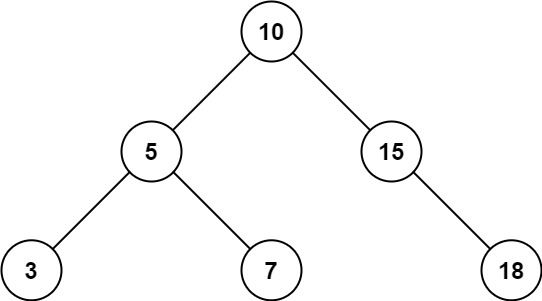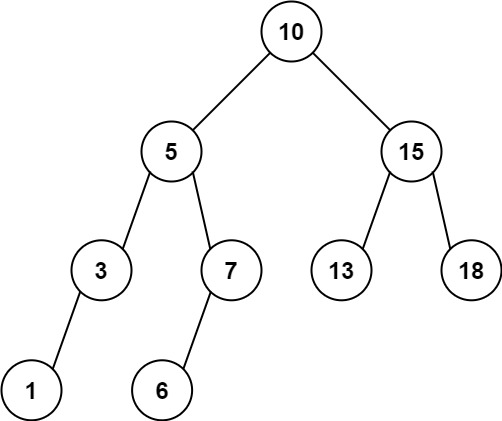- {x}
- Binary Subarrays With Sum
- Minimum Falling Path Sum
- Beautiful Array
- Number of Recent Calls
- Shortest Bridge
- Knight Dialer
- Stamping The Sequence
- Reorder Data in Log Files
- Range Sum of BST
- Minimum Area Rectangle
- Distinct Subsequences II
- Valid Mountain Array
- DI String Match
- Find the Shortest Superstring
- Delete Columns to Make Sorted
- Minimum Increment to Make Array Unique
- Validate Stack Sequences
- Read More...

Range Sum of BST
Given the root node of a binary search tree and two integers low and high, return the sum of values of all nodes with a value in the inclusive range [low, high].
Example 1:

Input: root = [10,5,15,3,7,null,18], low = 7, high = 15 Output: 32 Explanation: Nodes 7, 10, and 15 are in the range [7, 15]. 7 + 10 + 15 = 32.
Example 2:

Input: root = [10,5,15,3,7,13,18,1,null,6], low = 6, high = 10 Output: 23 Explanation: Nodes 6, 7, and 10 are in the range [6, 10]. 6 + 7 + 10 = 23.
Constraints:
- The number of nodes in the tree is in the range
[1, 2 * 104]. 1 <= Node.val <= 1051 <= low <= high <= 105- All
Node.valare unique.
Solution Explanation: Range Sum of BST
This problem asks us to find the sum of all node values within a given range [low, high] in a Binary Search Tree (BST). The efficient approach leverages the properties of a BST to minimize the number of nodes visited.
Algorithm (Depth-First Search - DFS):
The core idea is to perform a depth-first traversal of the BST. For each node encountered, we check if its value falls within the specified range [low, high].
-
Base Case: If the current node is
null(empty), we return 0 (no contribution to the sum). -
Range Check: If the node's value is within the range [low, high], we add its value to the sum.
-
Recursive Calls: Because it's a BST:
- If the node's value is greater than
low, there might be nodes within the range in its left subtree. We recursively call the function on the left subtree. - If the node's value is less than
high, there might be nodes within the range in its right subtree. We recursively call the function on the right subtree.
- If the node's value is greater than
-
Return Value: The function returns the accumulated sum for the subtree rooted at the current node.
Time and Space Complexity:
-
Time Complexity: O(N) - In the worst case, we might have to visit all N nodes in the BST. However, because of the BST property, we significantly prune the search space compared to a brute-force approach on a general tree.
-
Space Complexity: O(H) - The space complexity is determined by the maximum depth (H) of the recursion stack during the DFS traversal. In a balanced BST, H is log(N), while in a skewed BST, H can be N. Therefore, the space complexity is O(H), where H is the height of the tree.
Code Implementation (Python):
class TreeNode:
def __init__(self, val=0, left=None, right=None):
self.val = val
self.left = left
self.right = right
def rangeSumBST(root, low, high):
def dfs(node):
if not node:
return 0
sum_val = node.val if low <= node.val <= high else 0
if node.val > low:
sum_val += dfs(node.left)
if node.val < high:
sum_val += dfs(node.right)
return sum_val
return dfs(root)
# Example usage:
root = TreeNode(10, TreeNode(5, TreeNode(3), TreeNode(7)), TreeNode(15, TreeNode(13), TreeNode(18)))
low = 7
high = 15
result = rangeSumBST(root, low, high) # Output: 32
The code in other languages (Java, C++, Go, TypeScript, C#) follows the same algorithmic approach; only the syntax changes. The core logic of DFS and the range check remains consistent across all implementations.